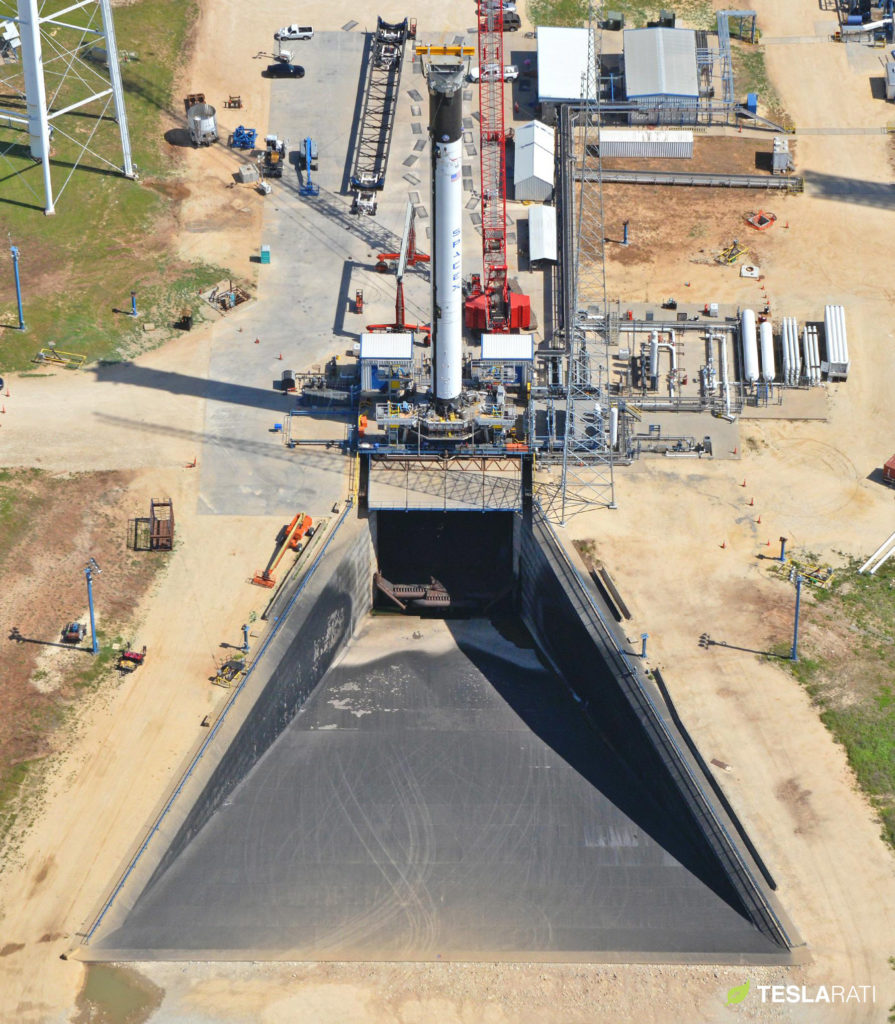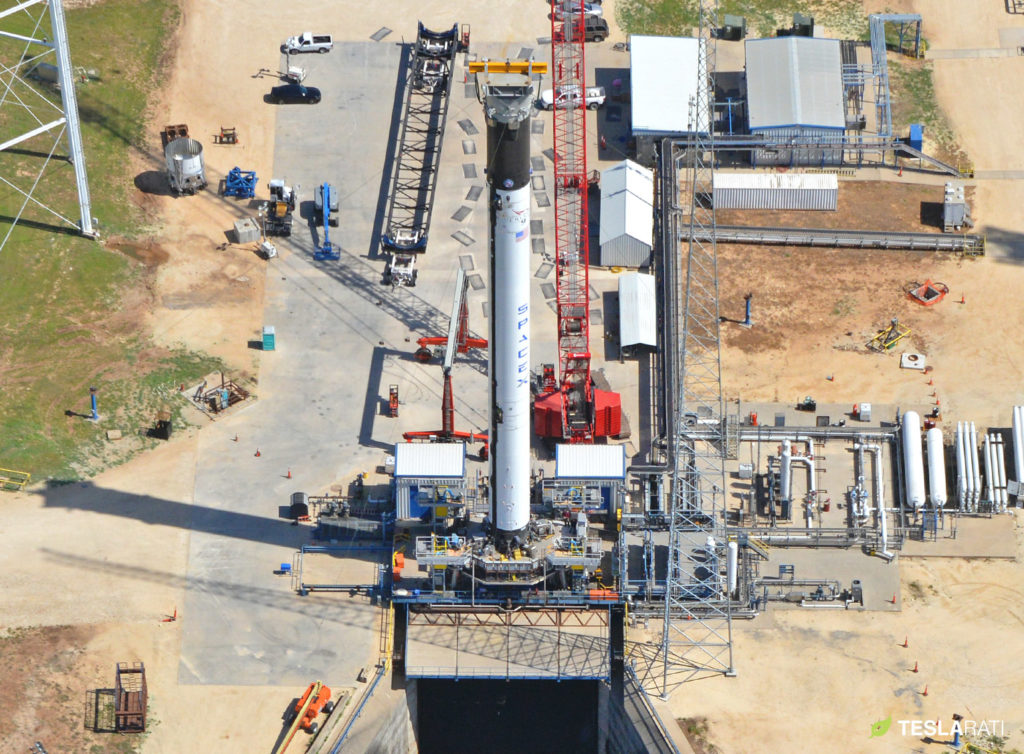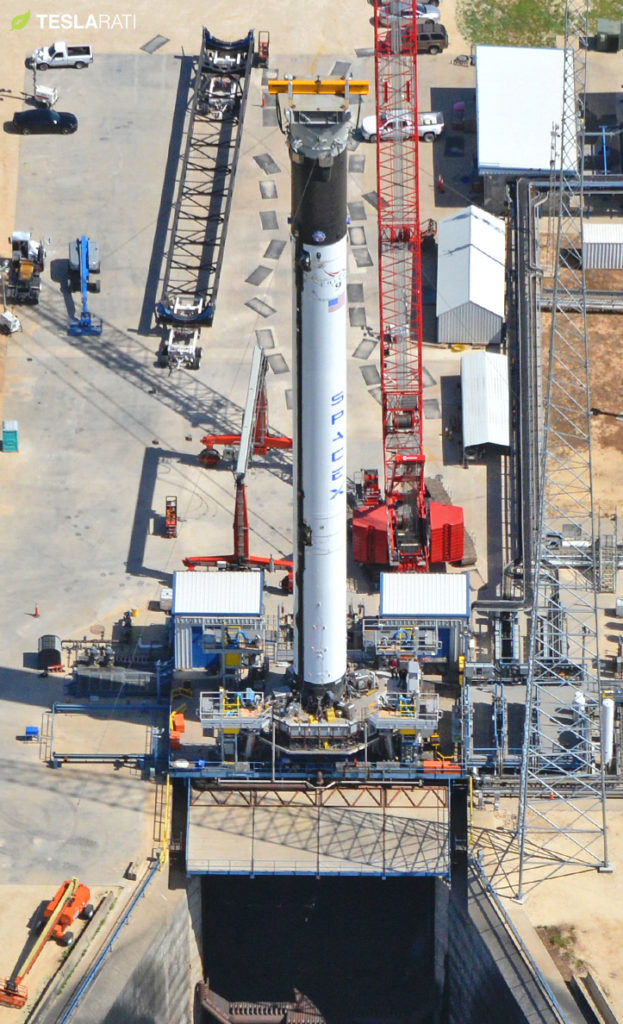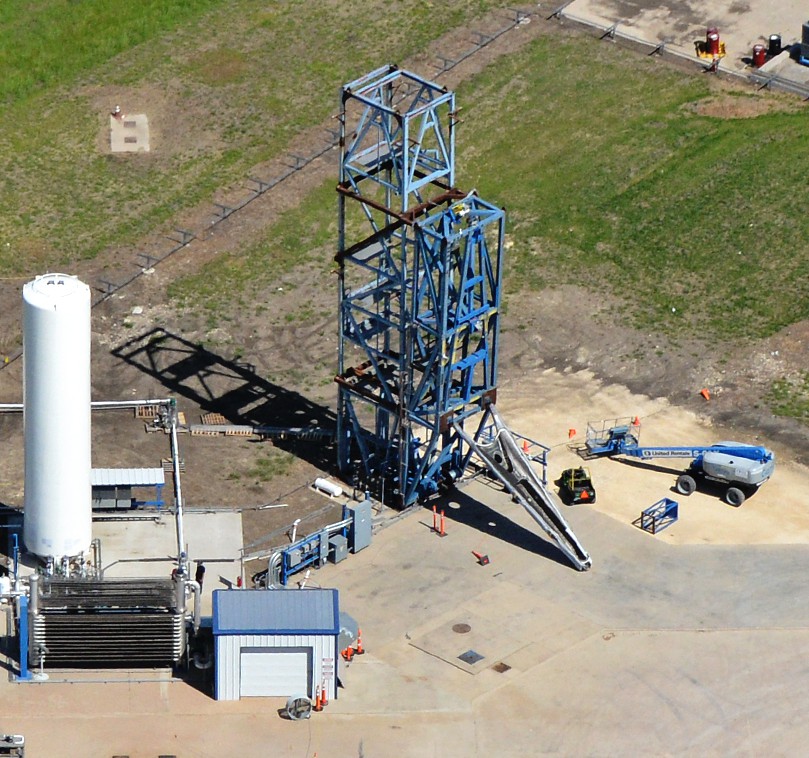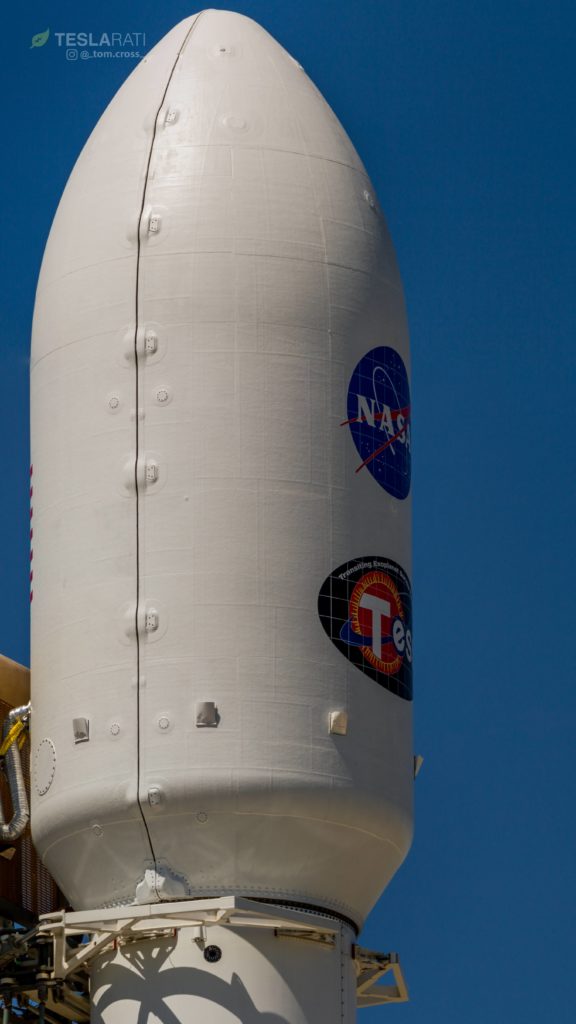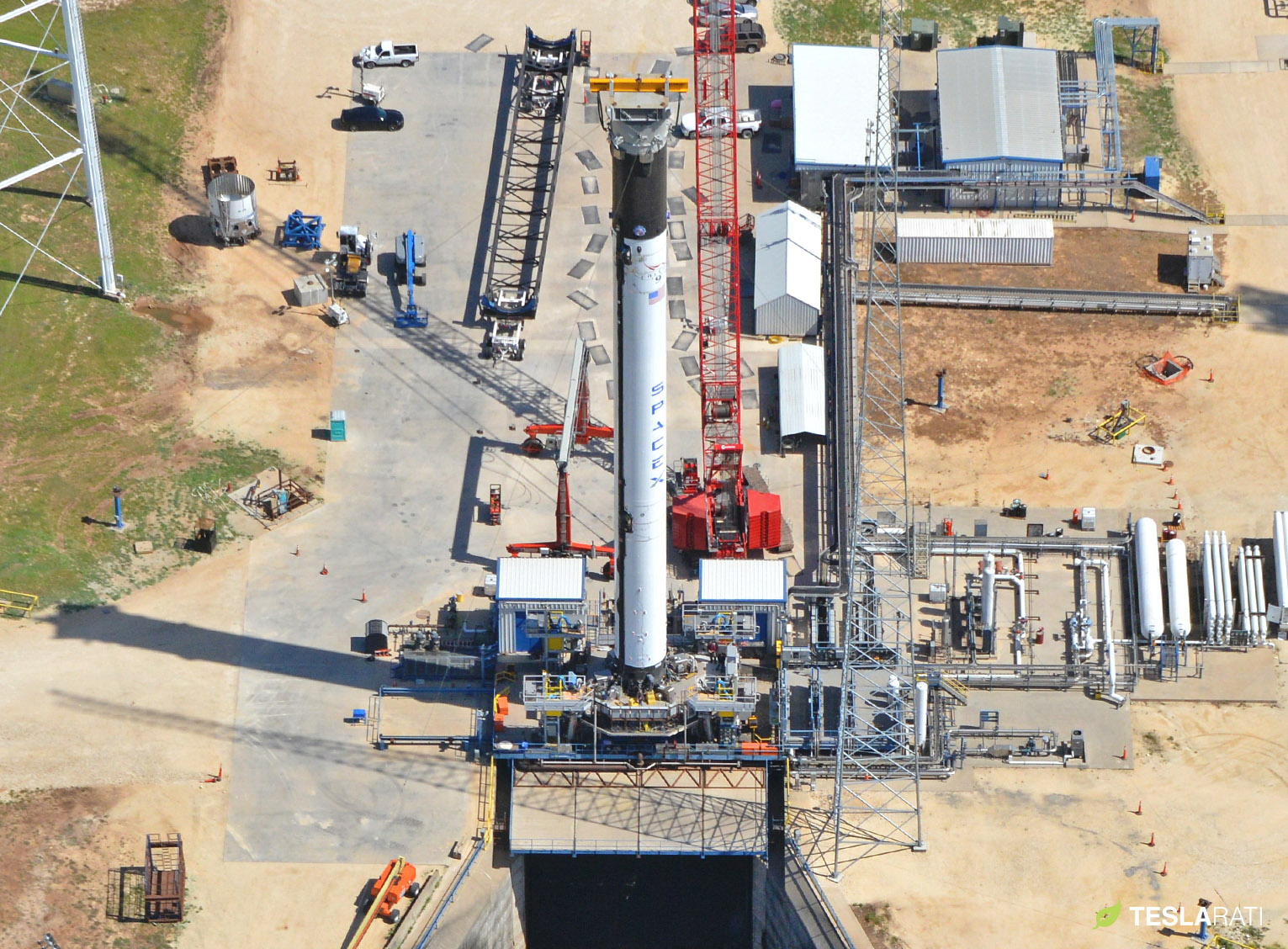
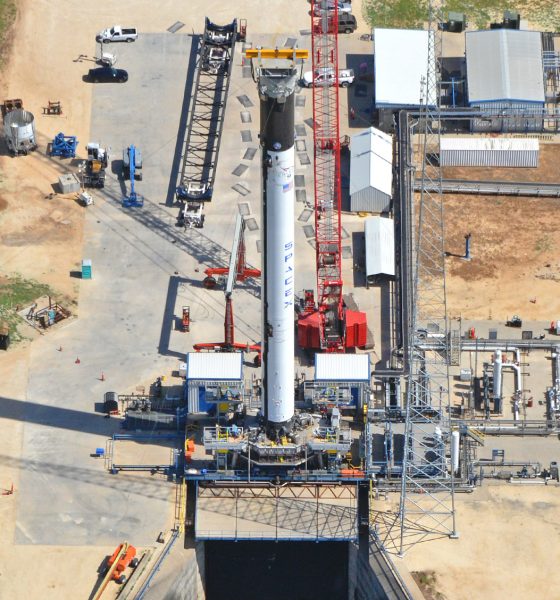
News
Second SpaceX Block 5 rocket spied in Texas, solidifying May 4 debut
Following reports from SpaceX’s Hans Koenigsmann that the company’s newest Falcon 9 Block 5 soared through its first hot-fire testing faster than any of the rocket’s previous upgrades, the second Block 5 booster has been spotted vertical, prepping for its own round of static-fire testing in McGregor, Texas.
After a thorough period of tests for the first Block 5 booster B1046, spotted partway through by NASASpaceflight’s forum member Gary Blair (ScaryDare), the presence of what can only be B1047 backs up Hans’ comments beyond a shadow of doubt. B1046 is now understood to be awaiting its inaugural on-pad static fire and launch at SpaceX’s Pad 39A, currently scheduled for NET May 4. While not entirely clear at this point, B1047 will most likely return to California after its test campaign in Texas, supplying SpaceX’s Vandenberg AFB launch site with a highly reusable booster.
- SpaceX’s second Block 5 booster was spotted vertical at the company’s McGregor, TX testing facilities. That booster has since been shipped to Florida for a mid-July launch, with B1048 now in its place as of June 15. (Aero Photo)
- SpaceX’s second Falcon 9 Block 5 booster was spied by an aerial photographer in Texas, April 17. (Aero Photo)
- B1047 captured testing in McGregor, Texas, April 2018. (Teslarati/Aero Photo)
If flight-testing shows that Block 5 is as easily and rapidly reusable as SpaceX engineers and techs intended, it’s entirely possible that B1047 will become the de facto Falcon 9 booster for most – if not all – upcoming VAFB missions, at least until additional boosters are completed, tested, and readied for flight operations. In a sense, SpaceX could be just weeks away from orbital rocket activities that all but mirror the sort of attitudes given towards modern aircraft, where one or several aircraft services contain specific routes and airports – or orbits and launch pads, in the case of Falcon 9.
In the history of reusable launch vehicles, the Space Shuttle is the only example that ever came close to the sort of regular reflights promised by Block 5 (and apparently even Block 4). If all goes as planned, the booster that launched TESS (B1045) will complete its second mission as early as June 28, requiring refurbishment in as few as 72 days, well over twice as fast as most previous reflights. Around the program’s cadence peak in the 1980s, Space Shuttle Atlantis flew two orbital missions in 54 days, and Falcon 9 Block 4 was by no means designed for rapid or repeated reuse and refurbishment.
- The same April 2018 flight captured what appears to be a Block 5 landing leg undergoing testing at a specially-designed test stand. (Aero Photo)
- Block 5 landing legs will be capable of retracting, much more efficient than the current process of removing each leg individually once boosters are returned to land or their port. They can be expected to look very similar to Block 4 legs shown here, albeit all black.(Tom Cross)
- SpaceX engineers and technicians have begun an aggressive campaign hoping to recover and reuse fairings ASAP. (Tom Cross)
If Block 5 becomes twice as reusable as Block 4, it will effectively usher in a new era of orbital access – Falcon 9’s booster accounts for over 70% of the rocket’s entire cost, and the payload fairing (~10%) is well on its way to recovery and reuse. Before the introduction of the fully-reusable BFR spaceship and booster, CEO Elon Musk recently confirmed that SpaceX will attempt to recover Falcon 9’s second stage, the only other critical component of the rocket that is now expended outright, mission permitting.
https://www.instagram.com/p/BhoeF43lxoX/?taken-by=erikkuna
Follow us for live updates, behind-the-scenes sneak peeks, and a sea of beautiful photos from our East and West coast photographers.
Teslarati – Instagram – Twitter
Tom Cross – Twitter
Pauline Acalin – Twitter
Eric Ralph – Twitter

Elon Musk
Starlink passes 9 million active customers just weeks after hitting 8 million
The milestone highlights the accelerating growth of Starlink, which has now been adding over 20,000 new users per day.

SpaceX’s Starlink satellite internet service has continued its rapid global expansion, surpassing 9 million active customers just weeks after crossing the 8 million mark.
The milestone highlights the accelerating growth of Starlink, which has now been adding over 20,000 new users per day.
9 million customers
In a post on X, SpaceX stated that Starlink now serves over 9 million active users across 155 countries, territories, and markets. The company reached 8 million customers in early November, meaning it added roughly 1 million subscribers in under seven weeks, or about 21,275 new users on average per day.
“Starlink is connecting more than 9M active customers with high-speed internet across 155 countries, territories, and many other markets,” Starlink wrote in a post on its official X account. SpaceX President Gwynne Shotwell also celebrated the milestone on X. “A huge thank you to all of our customers and congrats to the Starlink team for such an incredible product,” she wrote.
That growth rate reflects both rising demand for broadband in underserved regions and Starlink’s expanding satellite constellation, which now includes more than 9,000 low-Earth-orbit satellites designed to deliver high-speed, low-latency internet worldwide.
Starlink’s momentum
Starlink’s momentum has been building up. SpaceX reported 4.6 million Starlink customers in December 2024, followed by 7 million by August 2025, and 8 million customers in November. Independent data also suggests Starlink usage is rising sharply, with Cloudflare reporting that global web traffic from Starlink users more than doubled in 2025, as noted in an Insider report.
Starlink’s momentum is increasingly tied to SpaceX’s broader financial outlook. Elon Musk has said the satellite network is “by far” the company’s largest revenue driver, and reports suggest SpaceX may be positioning itself for an initial public offering as soon as next year, with valuations estimated as high as $1.5 trillion. Musk has also suggested in the past that Starlink could have its own IPO in the future.
News
NVIDIA Director of Robotics: Tesla FSD v14 is the first AI to pass the “Physical Turing Test”
After testing FSD v14, Fan stated that his experience with FSD felt magical at first, but it soon started to feel like a routine.

NVIDIA Director of Robotics Jim Fan has praised Tesla’s Full Self-Driving (Supervised) v14 as the first AI to pass what he described as a “Physical Turing Test.”
After testing FSD v14, Fan stated that his experience with FSD felt magical at first, but it soon started to feel like a routine. And just like smartphones today, removing it now would “actively hurt.”
Jim Fan’s hands-on FSD v14 impressions
Fan, a leading researcher in embodied AI who is currently solving Physical AI at NVIDIA and spearheading the company’s Project GR00T initiative, noted that he actually was late to the Tesla game. He was, however, one of the first to try out FSD v14.
“I was very late to own a Tesla but among the earliest to try out FSD v14. It’s perhaps the first time I experience an AI that passes the Physical Turing Test: after a long day at work, you press a button, lay back, and couldn’t tell if a neural net or a human drove you home,” Fan wrote in a post on X.
Fan added: “Despite knowing exactly how robot learning works, I still find it magical watching the steering wheel turn by itself. First it feels surreal, next it becomes routine. Then, like the smartphone, taking it away actively hurts. This is how humanity gets rewired and glued to god-like technologies.”
The Physical Turing Test
The original Turing Test was conceived by Alan Turing in 1950, and it was aimed at determining if a machine could exhibit behavior that is equivalent to or indistinguishable from a human. By focusing on text-based conversations, the original Turing Test set a high bar for natural language processing and machine learning.
This test has been passed by today’s large language models. However, the capability to converse in a humanlike manner is a completely different challenge from performing real-world problem-solving or physical interactions. Thus, Fan introduced the Physical Turing Test, which challenges AI systems to demonstrate intelligence through physical actions.
Based on Fan’s comments, Tesla has demonstrated these intelligent physical actions with FSD v14. Elon Musk agreed with the NVIDIA executive, stating in a post on X that with FSD v14, “you can sense the sentience maturing.” Musk also praised Tesla AI, calling it the best “real-world AI” today.
News
Tesla AI team burns the Christmas midnight oil by releasing FSD v14.2.2.1
The update was released just a day after FSD v14.2.2 started rolling out to customers.

Tesla is burning the midnight oil this Christmas, with the Tesla AI team quietly rolling out Full Self-Driving (Supervised) v14.2.2.1 just a day after FSD v14.2.2 started rolling out to customers.
Tesla owner shares insights on FSD v14.2.2.1
Longtime Tesla owner and FSD tester @BLKMDL3 shared some insights following several drives with FSD v14.2.2.1 in rainy Los Angeles conditions with standing water and faded lane lines. He reported zero steering hesitation or stutter, confident lane changes, and maneuvers executed with precision that evoked the performance of Tesla’s driverless Robotaxis in Austin.
Parking performance impressed, with most spots nailed perfectly, including tight, sharp turns, in single attempts without shaky steering. One minor offset happened only due to another vehicle that was parked over the line, which FSD accommodated by a few extra inches. In rain that typically erases road markings, FSD visualized lanes and turn lines better than humans, positioning itself flawlessly when entering new streets as well.
“Took it up a dark, wet, and twisty canyon road up and down the hill tonight and it went very well as to be expected. Stayed centered in the lane, kept speed well and gives a confidence inspiring steering feel where it handles these curvy roads better than the majority of human drivers,” the Tesla owner wrote in a post on X.
Tesla’s FSD v14.2.2 update
Just a day before FSD v14.2.2.1’s release, Tesla rolled out FSD v14.2.2, which was focused on smoother real-world performance, better obstacle awareness, and precise end-of-trip routing. According to the update’s release notes, FSD v14.2.2 upgrades the vision encoder neural network with higher resolution features, enhancing detection of emergency vehicles, road obstacles, and human gestures.
New Arrival Options also allowed users to select preferred drop-off styles, such as Parking Lot, Street, Driveway, Parking Garage, or Curbside, with the navigation pin automatically adjusting to the ideal spot. Other refinements include pulling over for emergency vehicles, real-time vision-based detours for blocked roads, improved gate and debris handling, and Speed Profiles for customized driving styles.
